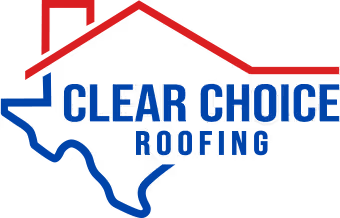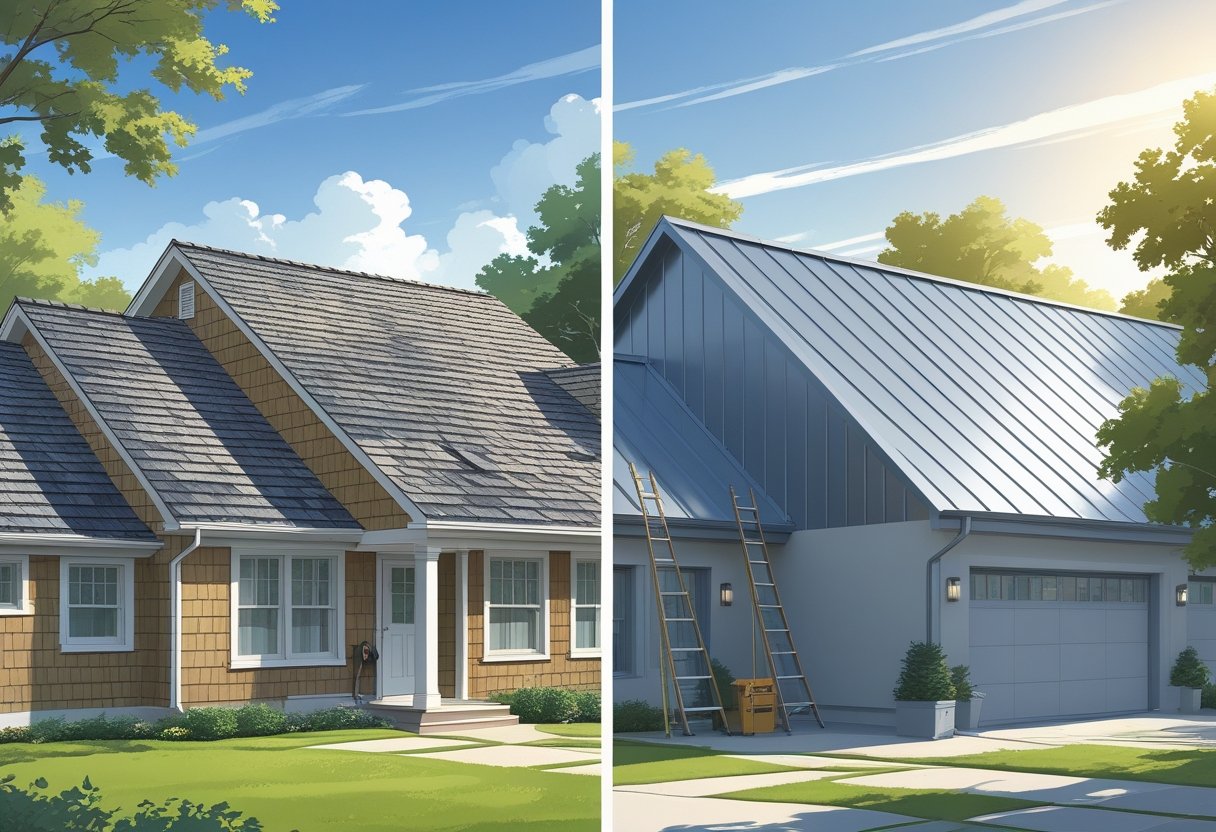When deciding between shingles and a metal roof, the cost is a major factor that homeowners consider. Generally, asphalt shingles are the more affordable option upfront, with installation costs for a 2,000-square-foot roof averaging around $7,900, compared to $18,600 for a metal roof. Beyond initial expenses, long-term factors such as durability and maintenance play a significant role in your decision.
Shingles provide quick and easy installation, making them an attractive choice for budget-conscious individuals. However, investing in a metal roof could prove cost-effective over time due to its longevity and resilience against harsh weather. With years of experience, Clear Choice Roofing can guide you through the nuances of each option while ensuring you make an informed choice tailored to your needs.
Ultimately, weighing the initial costs against potential long-term savings is crucial for homeowners. If you're looking to explore your roofing options in the Austin area, Clear Choice Roofing is here to assist you, ensuring that your investment is both wise and protective for your home.
Comparing Metal Roofs and Shingle Roofs
When deciding between metal roofs and shingle roofs, it’s essential to understand the attributes of each option. Cost, durability, energy efficiency, and lifespan are critical factors that can influence your decision.
Overview of Roofing Materials
Metal roofs are made from durable materials such as steel, aluminum, or copper. They are renowned for their longevity and resilience against harsh weather conditions. In contrast, asphalt shingles are the most commonly used roofing material. They come in various styles and colors, providing more options for aesthetic appeal. Shingles are typically cheaper upfront, making them an attractive choice for budget-conscious homeowners. However, while both roofing types offer unique benefits, their long-term performance varies significantly, which can influence overall costs.
Key Differences in Longevity and Durability
Metal roofs can last anywhere from 30 to 70 years, depending on the material used. They resist rot, fire, and insects, making them a robust option for those seeking durability. In comparison, asphalt shingles generally have a lifespan of 15 to 30 years. They are susceptible to damage from winds and hail storms. While shingles are easier and cheaper to replace, the need for more frequent replacements can add up over time. If you prioritize longevity and reduced maintenance, metal roofing may be the better investment.
Energy Efficiency and Environmental Factors
Metal roofs reflect solar radiant heat, which can reduce cooling costs by 10-25%. This energy efficiency is beneficial for homeowners in hotter climates. Asphalt shingles, while affordable, absorb heat and may contribute to higher energy bills during summer months. Additionally, many metal roofing options are made from recycled materials, making them an eco-friendly choice. Shingles typically have a shorter life cycle and may end up in landfills more frequently. By choosing metal roofing, you not only enhance energy efficiency but also reduce your environmental footprint, aligning with sustainable practices.
At Clear Choice Roofing, our knowledgeable team can guide you through the options that will best suit your home. Whether you choose metal or shingles, it’s essential to select a roofing material that meets your needs for cost, durability, and efficiency.
Cost Breakdown: Metal Roof vs. Shingles
When deciding between a metal roof and asphalt shingles, understanding the costs involved is essential. Key factors include material costs, labor and installation expenses, and an analysis of the initial financial outlay.
Material Costs
The material costs for roofing can vary significantly. A metal roof typically ranges from $8 to $12 per square foot, while asphalt shingles cost between $3 to $6 per square foot. For a 2,000-square-foot home, you can expect to pay around $18,600 for metal roofing compared to about $7,900 for asphalt shingles, as indicated by This Old House.
It’s important to factor in the specific type of metal you’re considering—steel, aluminum, or copper—each has its own price point. While metal roofs might have a higher upfront cost, they often come with a longer lifespan and lower maintenance needs, making long-term costs a consideration as well.
Labor and Installation Costs
Labor and installation costs can also impact your overall roofing expenditure. Generally, metal roofs may require a higher installation cost due to their specific techniques and additional materials, such as underlayment and finishing. This can raise labor costs to about $1.50 to $3.50 per square foot for metal roofing.
In contrast, asphalt shingle installation typically ranges from $1 to $2.50 per square foot. Therefore, while metal roofs come with a robust lifespan and durability, the installation process is often more labor-intensive. Companies like Clear Choice Roofing have the expertise to ensure a high-quality installation, protecting your investment.
Upfront Cost Analysis
When analyzing upfront costs, it’s clear that asphalt shingles represent a more affordable option initially. For a typical installation, the total costs may run approximately $9,400 for shingles compared to $23,600 for metal roofing, which encompasses both materials and installation.
However, it's wise to consider the long-term value. Metal roofs may cost more upfront, but they last significantly longer—often 50 years or more compared to the 20 years you might expect from asphalt shingles. Over time, you might find that investing in a metal roof yields greater savings in maintenance and replacements. Your choice should align with your budget and your long-term goals for your home.
Long-Term Costs and Value
When considering roofing options, you must evaluate not just the initial expenses, but also the long-term costs and value associated with each choice. The factors of maintenance, lifespan, and potential impact on resale value play a significant role in determining which roofing solution is more advantageous.
Maintenance and Repair Expenses
Asphalt shingle roofs typically require more frequent maintenance and repairs compared to metal roofs. Shingles may need patching and replacement every few years, especially in areas prone to harsh weather. Conversely, metal roofs are known for their low maintenance requirements and long durability. Most issues that arise with metal roofing are minor and can be resolved quickly, resulting in less expenditure over time.
By choosing a material with lower maintenance costs, like metal, you limit ongoing financial burdens. While your initial investment may be higher, the long-term savings can be substantial. Clear Choice Roofing can help you navigate these costs and make an informed decision.
Lifespan and Long-Term Savings
The lifespan of a roofing system significantly contributes to its value over time. Asphalt shingles usually last about 15 to 30 years, while metal roofs can last 40 to 70 years or more. This durability leads to fewer roof replacements throughout your homeownership.
With metal roofs, the initial cost is often offset by lower maintenance and repair expenses over their lifespan. Investing in a metal roof can yield long-term savings, as you won't be faced with regular replacement costs every couple of decades. Clear Choice Roofing can assure you of quality installation that maximizes durability and extends the life of your roof.
Impact on Resale Value
Your choice of roofing material can affect your property's resale value. Houses with metal roofs tend to attract higher offers due to the perceived long-term value and durability. On the other hand, while asphalt shingles might lower upfront costs, future buyers may be wary of the potential need for replacement or repairs sooner than they would with a metal option.
Investing in a metal roof can enhance your home's appeal and value in the real estate market. Therefore, choosing wisely between shingles and metal can be an investment that pays off significantly when selling your home, making it essential to evaluate the benefits accordingly.
Factors Affecting Roofing Costs
When considering roofing options, various factors will significantly influence your costs. Understanding these elements can help you make informed decisions.
Roof Size and Design
The size and design of your roof play crucial roles in determining costs. Larger roofs require more materials and labor, leading to higher expenses. Complex designs, such as those with multiple slopes, dormers, or valleys, can also complicate installation, increasing labor costs.
Additionally, the choice of roofing materials affects pricing. Accessing hard-to-reach areas may necessitate specialized equipment or extra safety measures, adding to overall expenses. Simple designs reduce labor and material costs, making them a more budget-friendly option.
Weight and Structural Considerations
The weight of your chosen roofing material can impact both the structure of your home and installation costs. Metal roofs tend to be lighter than asphalt shingles, which can lessen the need for additional structural support. Your existing roof structure must be evaluated to ensure it can handle the chosen roofing material's weight.
Using heavier materials may require reinforcements, resulting in increased labor and material costs. Consulting with professionals at Clear Choice Roofing can help assess your roof's structural capabilities and guide your decision.
Accessibility and Local Labor Rates
Accessibility plays a vital role in installation costs. Roofs that are difficult to access may require more time and effort from roofing contractors. This can increase labor costs significantly.
Local labor rates also influence overall expenses. In areas where skilled labor is in high demand, you may encounter higher prices. Obtaining multiple quotes from contractors, such as Clear Choice Roofing, can help compare local rates and find a fair price for your roofing project. Always ensure you're hiring reputable professionals to maintain quality during installation.
Other Considerations Beyond Price
While cost is a significant factor in choosing between shingles and metal roofing, various other aspects also play a crucial role in your decision-making process. These elements include aesthetics, performance in extreme weather, noise levels, and environmental impacts.
Aesthetics and Curb Appeal
When it comes to aesthetics, both shingles and metal roofs offer distinct styles. Asphalt shingles provide a traditional look, available in various colors and designs that can complement any home. Conversely, metal roofing boasts a modern appearance with sleek lines and finishes, enhancing modern curb appeal.
Many homeowners appreciate the reflective properties of metal roofs, which can add a unique dimension to your home's exterior. Depending on your neighborhood’s style and your personal preferences, choosing a roofing system that enhances your home's overall appearance is essential. Enhanced curb appeal can increase your property value when you decide to sell.
Performance in Extreme Weather
Performance is critical in areas prone to extreme weather, including high winds, hail, and intense heat. Metal roofs excel in high-wind areas, often withstanding gusts exceeding 140 mph. They are less likely to crack or curl under such conditions, making them a durable option.
Shingles can also perform well, specifically architectural shingles, but they may not offer the same level of protection. During high winds, shingles can be vulnerable to lifting and blowing off. Additionally, metal roofs reflect sunlight, which can help maintain a cooler home in hot climates, potentially lowering cooling costs over time.
Noise and Comfort
Noise levels are an important consideration, particularly in areas prone to storms or heavy rain. Metal roofs can be noisier than shingles during rain, leading to concerns about comfort. However, proper insulation and attic ventilation play a significant role in mitigating noise.
Shingles tend to absorb sound better due to their material properties, providing a quieter living environment. Consider your local environment and how often you experience intense weather when deciding between roofing options, as this may affect your comfort indoors.
Environmental Impact and Energy Savings
If you’re environmentally conscious, the environmental impact of your roofing choice matters. Metal roofs are typically made from recycled materials and are recyclable at the end of their lifespan. This makes them a more sustainable option compared to traditional asphalt shingles, which contribute to landfill waste.
Moreover, metal roofs often include reflective coatings that can lead to energy savings. They can significantly reduce cooling costs in warm climates by reflecting more sunlight. In contrast, while shingles may offer some energy-efficient options, the potential long-term energy savings typically favor metal roofs.
Clear Choice Roofing understands the implications of these considerations and can help you make the right choice based on your needs and the specifics of your property.
Choosing the Most Cost-Effective Roofing Solution
When deciding between shingles and metal roofing, it's essential to weigh the advantages and disadvantages of each option. Understanding these factors can help you make an informed choice that aligns with both your budget and needs.
Pros and Cons of Metal Roofs
Metal roofs, including standing seam metal roofs, offer notable durability and longevity, lasting 40-70 years. They require less maintenance and are resistant to severe weather conditions. However, the initial installation cost is higher compared to shingles. Some homeowners may find the sound of rain on metal to be a drawback. Additionally, metal roofs can be prone to denting from hail, depending on the material used.
Pros:
- Long lifespan
- Low maintenance
- Energy-efficient options available
Cons:
- Higher upfront costs
- Potential noise during rain
- Susceptible to dents
Pros and Cons of Shingle Roofs
Roofing shingles, especially asphalt varieties, remain popular for their affordability and ease of installation. They typically last 15-30 years, making them a suitable short to medium-term option. Shingles are available in various styles and colors, providing aesthetic versatility. However, they require more frequent maintenance and can be less durable against extreme weather compared to metal.
Pros:
- Lower initial costs
- Easy to install
- Variety of styles and colors
Cons:
- Shorter lifespan
- More maintenance needed
- Less resistant to severe weather
How to Make the Best Choice for Your Home
Choosing the most cost-effective roofing solution depends on multiple factors, including budget, climate, and personal preference. If you plan to stay in your home long-term, investing in a metal roof may save you money over time through durability and energy efficiency. Conversely, if you are on a tight budget and prefer immediate savings, shingles might be the right choice for you.
Consider consulting with a reliable roofing company like Clear Choice Roofing to get expert advice tailored to your specific situation. They can provide insights to help you navigate the options, ensuring you make a decision that protects your investment effectively.
Frequently Asked Questions
Understanding the differences between metal roofs and asphalt shingles can help you make an informed decision. This section addresses common questions regarding costs, benefits, life expectancy, and performance in various climates.
How do cost differences between metal roofs and asphalt shingles compare?
The installation cost for a metal roof typically ranges from $4 to $30 per square foot, while asphalt shingles can cost between $1.50 and $4 per square foot. This means metal roofs generally require a higher initial investment compared to shingles.
What are the pros and cons of metal roofs versus shingle roofs?
Metal roofs offer longevity and durability, often lasting 40-70 years, while asphalt shingles typically last 15-30 years. On the downside, metal roofs can be more expensive upfront. Shingles are more economical, but they might require replacements sooner due to wear and tear.
What is the life expectancy of metal roofs compared to shingle roofs?
Metal roofs can last between 40 to 70 years, making them a long-term investment. Conversely, asphalt shingles usually need replacement every 15 to 30 years, depending on the quality and local weather conditions. This difference significantly impacts the total lifecycle cost of roofing.
How do metal roofs perform in hot climates versus shingle roofs?
Metal roofs reflect sunlight effectively, which can reduce cooling costs in hot climates. Asphalt shingles can absorb heat, potentially increasing energy bills during peak summer months. If you live in such areas, consider how each option impacts energy efficiency.
What are some potential downsides to installing a metal roof?
While metal roofs are durable, they can be prone to dents from hail or heavy debris. Installation costs are higher compared to asphalt shingles, which may not fit every budget. Additionally, noise during rain or hail can be a concern for some homeowners.
What type of roof is generally the most affordable to install?
Asphalt shingles are typically the most affordable roofing option available. Their lower material costs and quicker installation timelines make them a common choice for budget-conscious homeowners. If financing is an important aspect, asphalt shingles offer a clear advantage in initial expenses.
For all your roofing needs, including expert advice and installation, consider reaching out to Clear Choice Roofing. Their local expertise ensures you receive quality service tailored to your specific requirements.



